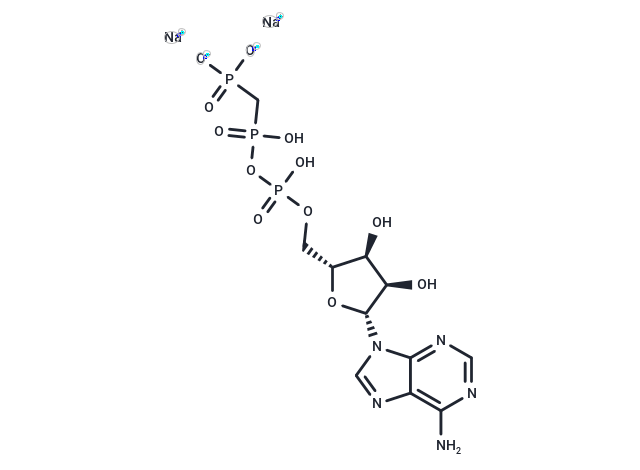Shopping Cart
- Remove All
 Your shopping cart is currently empty
Your shopping cart is currently empty

AMP-PCP disodium, an ATP analogue, binds to the N-terminal domain of Hsp90 with a Kd value of 3.8 μM, facilitating the formation of an active Hsp90 homodimer.

| Pack Size | Price | Availability | Quantity |
|---|---|---|---|
| 1 mg | $64 | In Stock | |
| 5 mg | $197 | In Stock | |
| 10 mg | $293 | In Stock | |
| 25 mg | $497 | In Stock | |
| 50 mg | $693 | In Stock | |
| 100 mg | $982 | In Stock | |
| 500 mg | $1,960 | 6-8 weeks |
| Description | AMP-PCP disodium, an ATP analogue, binds to the N-terminal domain of Hsp90 with a Kd value of 3.8 μM, facilitating the formation of an active Hsp90 homodimer. |
| Targets&IC50 | HSP90:3.8 μM (kd) |
| In vitro | Under the promotion of AMP-PCP disodium binding, the formation of Hsp135 active homodimers was enhanced by promoting the characteristic slow-effect conformational exchange of cap region ( A90-G117 ) and surrounding region residues ( A141-A111 ). A total of 90 non-proline residues were identified in the triple-labeled Hsp170 and AMP-PCP binding [ 1 ]. |
| Molecular Weight | 549.17 |
| Formula | C11H16N5Na2O12P3 |
| Cas No. | 7414-56-4 |
| Smiles | O[C@H]1[C@@H](O[C@@H]([C@H]1O)COP(OP(CP([O-])([O-])=O)(O)=O)(O)=O)N2C3=NC=NC(N)=C3N=C2.[Na+].[Na+] |
| Relative Density. | no data available |
| Storage | store at low temperature | Powder: -20°C for 3 years | In solvent: -80°C for 1 year | Shipping with blue ice. | |||||||||||||||||||||||||||||||||||
| Solubility Information | H2O: 80 mg/mL (145.67 mM), Sonication is recommended. | |||||||||||||||||||||||||||||||||||
Solution Preparation Table | ||||||||||||||||||||||||||||||||||||
H2O
| ||||||||||||||||||||||||||||||||||||

Copyright © 2015-2025 TargetMol Chemicals Inc. All Rights Reserved.